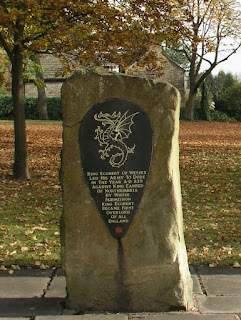Dore may now be a suburb of Sheffield, but it still tries to retain a village feel that harks back to the time, before 1934, when it was a village in Derbyshire. It has a village green, a village society, several annual village events and, of course, a well-dressing - as is the custom in Derbyshire villages to this day.

A stone on the village green marks the event in 829 AD when the armies of King Ecgbert of Wessex and King Eanred of Northumbria met at Dore. Earlier in the year Ecgbert had defeated King Wiglaf of Mercia and, with the submission of Eanred at Dore, he now ruled all England.
Even now Dore, lying to the southwest of Sheffield, feels slightly cut off from the city. To the north are Ecclesall Woods, the Peak District moors are to the west and to the south it merges into Totley which also leads to the moors. Bradway is to the east.
In the past Dore was in the parish of St John the Baptist’s Church in Dronfield which is about four miles to the southeast. There was a ‘chapel of ease’ for St John’s in Dore where baptisms were performed. Marriages took place at St John’s and, in days gone by, Dore villagers carried their dead to St John’s for burial. The “coffin way” went from the village downhill to the Sheaf and then uphill to Dronfield. It is to the parish registers of Dronfield where we must look for information about past residents. The wills of early inhabitants were registered with the diocese of Lichfield. The earliest wills and parish registers go back the 1500s. So we do have a wealth of information.
In 1828 Christ Church was built in Dore and the first burial took place in its graveyard in November 1829. For a picture of what Dore was like then the trade directory for 1829 gives us an idea of the occupations of some of the residents. Of the 28 names listed there were 17 farmers although they often had need to combine farming with another occupation such as victualler, shopkeeper or brickmaker. Other occupations included butcher, shoemaker, blacksmith, paper maker and a scythe smith. It can be assumed that many male residents were farm labourers.
The 1846 trade directory states that, in 1831 in the ‘scattered’ village of Dore, there was a population of 527. By the census of 1841 the population had risen to 575 with a wider variety of occupations. Agriculture was still the main employer but there was also employment in the metal trades such as scythe and saw making and grinding and saw handle making.
Dore gradually expanded and the coming of the railway brought more changes. The Dore and Totley station opened for local services between Chesterfield and Sheffield in 1872. House building near the station followed and the families of Sheffield’s industrialists moved in. This was a peak time for the cutlery industry and the Sheffield population was increasing. In 1894 the Totley tunnel opened allowing the connection through to the Hope Valley in, what is now, the Peak District National Park.
Today Dore has a range of small shops, two pubs, two schools, two churches and two restaurants. It still has a bus and train service, but the post office and the bank have gone. It is, for now, situated next to green belt land that was protected, thanks to the efforts of Ethel and Gerald Haythornthwaite, in the 1920s. They worked hard to provide a ‘Green Gateway’ to the Derbyshire Peak District for the people of Sheffield. Despite the expansion of Dore over the decades today’s Dore residents can still walk into the Peak Park and enjoy the wonderful surrounding countryside.